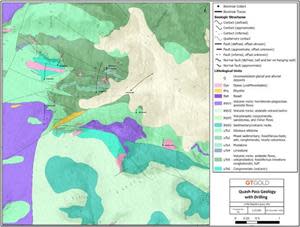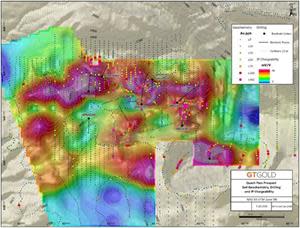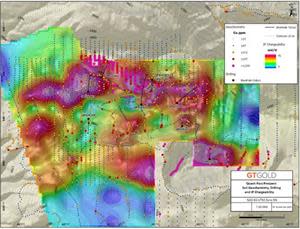GT Gold Reports Results From Quash Pass Drilling
Location of Quash Pass prospect, Tatogga Project, northwestern BC.

Figure 1.
Quash Pass geology and borehole location, Tatogga Project, northwestern BC.

Figure 2.
Quash Pass gold-in-soil anomalies, IP chargeability anomalies, borehole collars and traces, Tatogga Project, northwestern BC.

Figure 3.
Quash Pass copper-in-soil anomalies, IP chargeability anomalies, borehole collars and traces, Tatogga Project, northwestern BC.

Figure 4.
Quash Pass gold-in-soil anomalies, reduced-to-pole magnetic anomalies, borehole collars and traces, Tatogga Project, northwestern BC.

Figure 5.
VANCOUVER, British Columbia, Feb. 16, 2021 (GLOBE NEWSWIRE) -- GT Gold Corp. (TSX-V:GTT; OTCQX:GTGDF) (the “Company” or “GT Gold”) today announces the results of a drilling program at Quash Pass, on its Tatogga property in British Columbia.
Quash Pass Exploration Summary
The Quash Pass target covers an area of approximately fourteen square kilometres and is located seven kilometres to the south-southwest of the Saddle North and Saddle South discoveries. The target is a large-scale surface anomaly with reactive host rocks, chemistry variations, alteration, major structures and chemical signatures of both vein and porphyry style mineralization.
As further discussed later in this news release, the nine, very widely spaced reconnaissance boreholes drilled in 2020, returned narrow anomalous to weakly mineralized intersections for gold and copper. All the boreholes intersected significant distal, chlorite and epidote (“green rock”), alteration characteristic of mineralized porphyry systems, and anomalous base and precious metal mineralization. Further work will test deeper, blind targets by reviewing all available geochemical, geophysical and alteration vectors, to target potential deeper, blind mineralization. GT Gold has initiated a “green rock study” whereby mineral chemistry will be used as a vectoring tool to target potential mineralized potassic alteration zones in future drilling programs.
Details of the Quash Pass Drill Program
The Company completed an initial drill program at the Quash Pass target located approximately seven kilometres to the south-southwest of the Saddle North gold rich copper porphyry deposit and the Saddle South precious metal rich vein systems within the Tatogga Project (Figure 1). A total of nine (9) very widely spaced boreholes for 4,841.14 m were completed over the Quash Pass target (Table 1; Figure 2). The program was designed to commence the testing of a large area (14 km2) of coincident precious metal and base metal soil geochemical anomalies, geophysical anomalies (both Induced Polarization (IP) chargeability and magnetic), structural anomalies, surface alteration and evidence for both vein style and intrusion style mineralization (Figures 2 to 5).
Table 1. Quash Pass borehole statistics.
Borehole | Northing | Easting | Elevation | Azimuth | Inclination | Total Depth |
(#) | (m) | (m) | (m) | (°) | (°) | (m) |
QPD20-001 | 6401550 | 429501 | 1,856.8 | 000 | -50 | 600.00 |
QPD20-002 | 6401875 | 429802 | 1,940.4 | 020 | -60 | 541.78 |
QPD20-003* | 6401816 | 430925 | 1,658.3 | 180 | -60 | 22.61 |
QPD20-004 | 6401816 | 430925 | 1,658.3 | 180 | -60 | 522.00 |
QPD20-005 | 6401259 | 430685 | 1,575.0 | 000 | -50 | 1125.00 |
QPD20-006 | 6400046 | 432206 | 1,525.0 | 000 | -65 | 390.00 |
QPD20-007** | 6400787 | 431597 | 1,571.0 | 000 | -60 | 142.75 |
QPD20-008 | 6400946 | 429508 | 1,891.5 | 180 | -50 | 540.00 |
QPD20-009 | 6401296 | 431482 | 1,300.0 | 045 | -50 | 957.00 |
Total Metres | 4,841.14 | |||||
* QPD20-003 - Lost the borehole due to bad ground. QPD20-004 a redrill from same drill pad.
** QPD20-007 - Did not reach intended target due to bad ground conditions.
The geology of the Quash Pass target is characterized by a sequence of volcanic-volcaniclastic rocks of the Late Triassic Stuhini Group, unconformably overlain by, or in faulted contact to, pelitic sedimentary rocks of the Hazelton Group. These sequences are cross-cut by a series of predominantly east-west oriented intrusive bodies, of mainly monzonitic to dioritic composition and, minor intermediate to felsic dykes (Figure 2).
The alteration logged in the boreholes and identified from spectral data consists predominantly of chlorite and white mica (sericite) with carbonate overprint, discrete zones of epidote, very minor biotite and potassic alteration.
Mineralization is mainly characterized by thin to moderate (<1 m to 10 m) zones of pyrite bearing quartz and quartz-carbonate veins with minor to trace chalcopyrite and sulfosalts. Minor to moderate narrow base metal veins (galena-sphalerite±chalcopyrite) were intersected in the drilling. Pyrrhotite may be disseminated, in clusters and veinlets in both sedimentary and intrusive units and can extend over tens of metres down hole and correlates with high IP chargeability readings. Molybdenite bearing quartz veins were observed associated with mafic intrusions in the western portion of Quash Pass prospect. There is a good correlation between the distribution of sulphides and the intensity of the IP chargeability.
Table 2. Mineralized intercepts for Quash Pass boreholes QPD20-001 to QPD20-009
Borehole | From | To | Interval | Au | Ag | Cu | Pb | Zn |
(#) | (m) | (m) | (m) | (g/t) | (g/t) | (ppm) | (ppm) | (ppm) |
QPD20-001 | 303.00 | 304.50 | 1.50 | 0.41 | 2.09 | 141 | 158 | 759 |
553.85 | 554.73 | 0.88 | 1.24 | 79.80 | 2,880 | 5,330 | 38,000 | |
QPD20-002 | No significant intercept | |||||||
QPD20-004 | 271.50 | 273.00 | 1.50 | 1.48 | 0.94 | 164 | 20 | 95 |
QPD20-005 | 516.54 | 517.05 | 0.51 | 0.50 | 26.90 | 1,010 | 1,910 | 30,800 |
549.00 | 549.79 | 0.79 | 1.14 | 2.80 | 89 | 383 | 3,780 | |
665.00 | 666.50 | 1.50 | 0.38 | 0.32 | 26 | 16 | 70 | |
727.00 | 729.75 | 2.75 | 0.34 | 2.79 | 67 | 454 | 388 | |
1,015.00 | 1,019.50 | 4.50 | 0.90 | 4.95 | 306 | 188 | 2,389 | |
including: | ||||||||
1,016.50 | 1,018.00 | 1.50 | 1.99 | 6.98 | 293 | 205 | 1,070 | |
1,024.00 | 1,025.50 | 1.50 | 1.37 | 1.08 | 322 | 19 | 50 | |
1,034.50 | 1,039.00 | 4.50 | 0.30 | 0.42 | 126 | 36 | 226 | |
QPD20-006 | 12.00 | 16.50 | 4.50 | 0.35 | 0.68 | 47 | 135 | 616 |
25.50 | 28.50 | 3.00 | 0.44 | 1.33 | 36 | 189 | 898 | |
77.50 | 79.00 | 1.50 | 0.72 | 0.45 | 50 | 55 | 242 | |
150.00 | 150.86 | 0.86 | 0.43 | 1.63 | 49 | 207 | 1,820 | |
172.00 | 174.00 | 2.00 | 0.67 | 0.10 | 46 | 6 | 46 | |
216.00 | 226.00 | 10.00 | 0.29 | 0.72 | 110 | 233 | 910 | |
234.00 | 236.00 | 2.00 | 0.39 | 0.43 | 146 | 5 | 78 | |
258.00 | 260.00 | 2.00 | 0.63 | 0.50 | 131 | 6 | 86 | |
318.50 | 320.16 | 1.66 | 0.53 | 0.33 | 149 | 3 | 49 | |
QPD20-007 | No significant intercepts | |||||||
QPD20-008 | No significant intercepts | |||||||
QPD20-009 | 60.00 | 60.74 | 0.74 | 0.47 | 1.25 | 654 | 4 | 24 |
634.31 | 634.87 | 0.56 | 0.64 | 216.00 | 12 | 139 | 47 | |
672.00 | 673.00 | 1.00 | 0.36 | 79.30 | 1,305 | 87 | 1,060 | |
707.00 | 715.00 | 8.00 | 0.32 | 0.58 | 13 | 21 | 110 | |
737.00 | 743.00 | 6.00 | 0.37 | 0.36 | 8 | 8 | 82 | |
Green Rock Study
Exploration for both porphyry as well as epithermal vein deposits has become increasingly expensive with new discoveries often occurring at considerable depth or concealed by post mineral cover. However, with improved analytical techniques as well as global research initiatives, mineral chemistry has emerged as a viable exploration targeting tool in both the porphyry and epithermal mineralized environment.
As observed at the Saddle North gold rich copper porphyry, the deposit is centred within an alteration halo with characteristic mineralogical and chemical zonation patterns from a core of strong potassic alteration grading out to phyllic alteration on the margins. Drilling on this deposit has yet to determine the full extent of the mineralized and alteration halo. At the Quash Pass target the initial reconnaissance drilling intersected extensive chlorite and to a lessor extent epidote in drill core. Chlorite and epidote are great repositories of trace elements, the concentrations of which change systematically with distance from the centre of a mineralized system and have been shown to define a deposit footprint up to five kilometres or more beyond a deposit. This technique of using mineral chemistry to vector to mineralization has been shown to be successful in studies across five countries (Canada, USA, Chile, Australia and Philippines).
Given the extensive chlorite alteration encountered in the boreholes at Quash Pass, the Company has collected a total of twenty-two samples from the seven boreholes. The samples varied in length from 10-20 cm of drill core, from which both a thin and thick polished section was cut, as well as an aliquot prepared and sent for whole rock analysis. The selected sections are currently being investigated by optical microscopy as well as X-ray mapping by a Scanning Electron Microscope (SEM) and Laser Ablation-ICP-MS work. We expect the results in the second half of 2021 which will then guide further work at Quash Pass.
Photos accompanying this announcement are available at
https://www.globenewswire.com/NewsRoom/AttachmentNg/08faa8f8-7514-4fed-abdd-ab7790261e4d
https://www.globenewswire.com/NewsRoom/AttachmentNg/d4b57eaa-3bc2-4e0a-984d-bf9bcdbc06ea
https://www.globenewswire.com/NewsRoom/AttachmentNg/c63df07d-5165-421b-a217-78dca38908b0
https://www.globenewswire.com/NewsRoom/AttachmentNg/da19b727-da27-4617-b664-ebb1ad2c0ed8
https://www.globenewswire.com/NewsRoom/AttachmentNg/86303041-f5cb-42f7-93ba-0a9fed3d5e74
Quality Assurance
GT Gold has implemented a rigorous quality assurance / quality control (QA/QC) program to ensure best practices in sampling and analysis of diamond drill core, the details of which can be viewed on the Company's website at http://www.gtgoldcorp.ca/projects/tatogga/. All assays are performed by ALS Canada Ltd., with sample preparation carried out at the ALS facility in Terrace, BC, and assays at the North Vancouver laboratory. For gold, fire assays are performed as per ALS method Au-AA26 (0.01- 100 g/t Au) using 50 grams of sample measured by atomic absorption. Assays equal to or greater than 100 g/t Au are reanalyzed gravimetrically by method Au-GRA22. Silver and copper are analyzed by ALS method ME-MS61 with a 4-acid digestion followed by ICP-MS analysis. Assays greater than 100 ppm silver or 1% copper are reanalyzed by ICP-AES by method OG-62.
Qualified Person
In accordance with National Instrument 43-101 Standards of Disclosure for Mineral Projects, Michael Skead, FAusIMM, Vice President Projects, is the Qualified Person for the Company and has validated and approved the technical and scientific content of this news release.
About GT Gold
GT Gold is engaged in advancing its wholly-owned, 47,500 hectare Tatogga property, located in the renowned “Golden Triangle” near Iskut, British Columbia. To date, GT Gold has made two significant discoveries on the Tatogga property, “Saddle South”, a precious metal rich vein system and “Saddle North”, a gold-rich copper porphyry system. At Saddle North, the Company is currently working to complete a Preliminary Economic Assessment following the July 2020 release of its maiden mineral resource estimate comprising an Indicated resource of 1.81 Blb copper and 3.47 Moz gold and an Inferred resource of 2.98 Blb copper and 5.46 Moz gold.
Investor Contact
GT Gold Corp. | GT Gold Corp. |
Cautionary Statement Regarding Forward Looking Statements
This news release contains forward-looking statements and forward-looking information (together, "forward looking statements") within the meaning of applicable securities laws. All statements, other than statements of historical facts, are forward-looking statements. Generally, forward-looking statements can be identified by the use of terminology such as "plans", "expects”, "estimates", "intends", "anticipates", "believes" or variations of such words, or statements that certain actions, events or results "may", "could", "would", "might", "will be taken", "occur" or "be achieved". Forward looking statements involve risks, uncertainties and other factors disclosed under the heading “Risk Factors” and elsewhere in the Company’s filings with Canadian securities regulators, that could cause actual results, performance, prospects and opportunities to differ materially from those expressed or implied by such forward-looking statements. Although the Company believes that the assumptions and factors used in preparing these forward-looking statements are reasonable based upon the information currently available to management as of the date hereof, actual results and developments may differ materially from those contemplated by these statements. Readers are therefore cautioned not to place undue reliance on these statements, which only apply as of the date of this news release, and no assurance can be given that such events will occur in the disclosed times frames or at all. Except where required by applicable law, the Company disclaims any intention or obligation to update or revise any forward-looking statement, whether as a result of new information, future events or otherwise. Neither the TSX Venture Exchange nor its Regulation Services Provider (as that term is defined in the policies of the TSX Venture Exchange) accepts responsibility for the adequacy or accuracy of this release.

 Yahoo Finance
Yahoo Finance